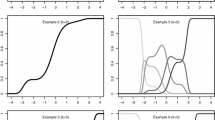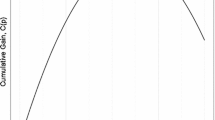Abstract
Given a Masters partial credit item withn known step difficulties, conditions are stated for the existence of a set of (locally) independent Rasch binary items such that their raw score and the partial credit raw score have identical probability density functions. The conditions are those for the existence ofn positive values with predetermined elementary symmetric functions and include the requirement that then step difficulties form an increasing sequence.
Similar content being viewed by others
References
Andersen, E. B. (1966).Den diskrete malingsmodel af endelig orden med anvendelse pa et socialpsykologisk materiale [A discrete latent trait model for ordered categories with applications to social psychology data]. Kobenhavn, Denmark: Statens Trykningskontor.
Andrich, D. (1978). A rating formulation for ordered response categories.Psychometrika, 43, 561–573.
Andrich, D. (1985). A latent trait model for items with response dependencies: Implications for test construction and analysis. In S. Embretson (Ed.).Test design: Contributions from psychology, education and psychometrics (pp. 245–273). New York: Academic Press.
Baxter, G. P., Shavelson, R. J., Goldman, S. R., & Pine, J. (1992). Evaluation of procedure-based scoring for hands-on science assessment.Journal of Educational Measurement, 29, 1–17.
Beckenbach, E. F. & Bellman, R. (1965).Inequalities (Second Revised Printing). Berlin: Springer-Verlag.
Bock, R. D. (1972). Estimating item parameters and latent ability when responses are scored in two or more latent categories.Psychometrika, 37, 29–51.
Brent, R. P. (1971). An algorithm with guaranteed convergence for finding a zero of a function.The Computer Journal, 14, 422–425.
Burnside, W. S. & Panton, A. W. (1892).Theory of equations (3rd ed.). Dublin: Dublin University Press Series.
David, F. N., Kendall, M. G. & Barton, D. E. (1966).Symmetric functions and allied tables. London: Cambridge University Press.
Fischer, G. H. (1974).Einfuhrung in die theorie psychologisher tests. Grundlagen und Anwendungen [Introduction to the theory of psychological tests. Foundations and applications]. Bern: Huber.
Haney, W. & Madaus, G. (1989). Searching for alternatives to standardized tests: Whys, whats, and withers. Phi Delta Kappan,70, 683–687.
Holland, P. W. (1990). On the sampling theory foundation of item response theory models.Psychometrika, 55, 577–601.
Huynh, H. & Ferrara, S. F. (in press). A comparison of equal percentile and partial credit equatings for performance-based assessments comprised of free-response items.Journal of Educational Measurement.
IMSL (1987).User's manual: Math/library—FORTRAN subroutines for mathematical applications. Houston: Author.
Macdonald, I. G. (1979).Symmetric functions and Hall polynomials. Oxford: Clarendon Press.
Masters, G. N. (1982). A Rasch model for partial credit scoring.Psychometrika, 47, 149–174.
Mehrens, W. A. (1992). Using performance assessment for accountability purposes.Educational Measurement: Issues and practice, 11, 3–9.
Muraki, E. (1990). Fitting a polytomous item response model to Likert-type data.Applied Psychological Measurement, 14, 59–71.
Muraki, E. (1992). A generalized partial credit model: Application of an EM algorithm.Applied Psychological Measurement, 16, 159–176.
Rasch, G. (1960).Probabilistic models for some intelligence and attainment tests. Copenhagen: Danish Institute for Educational Research.
Rasch, G. (1961). On general laws and the meaning of measurement in psychology.Proceedings of the IV Berkeley Symposium on mathematical statistics and probability (Vol. 4). Berkeley: University of California Press.
Rasch, G. (1967a). An informal report on a theory of objectivity in comparisons. In L. J. Th. van der Kamp & C. A. J. Vlek (Eds.),Measurement theory. Proceedings of the NUFFIC international summer session in science in “Het Oude Hof”, The Hague, July 14–28, 1966. Leyden: University of Leyden.
Rasch, G. (1967b). An individual-centered approach to item analysis with two categories of answers. In L. J. Th. van der Kamp & C. A. J. Vlek (Eds.),Measurement theory. Proceedings of the NUFFIC international summer session in science in “Het Oude Hof”, The Hague, July 14–28, 1966. Leyden: University of Leyden.
Samejima, F. (1972). A general model for free-response data.Psychometric Monograph No. 18, 37(1, Pt. 2).
Serret, J. A. (1928).Cours d'algèbre supérieure (7th ed.). Paris, France: Gauthier-Villars.
Smith, B. T. (1967).ZERPOL, A zero finding algorithm for polynomials using Laguerre's method. Toronto: University of Toronto, Department of Computer Science.
Thissen, D. & Steinberg, L. (1984). A response model for multiple-choice items.Psychometrika, 49, 501–519.
Thissen, D., Steinberg, L., & Mooney, J. (1989). Trace lines for testlets: A use of multiple-categorical response models.Journal of Educational Measurement, 26, 247–260.
Wainer, H., Sireci, S. G., & Thissen, D. (1991). Differential testlet functioning definitions and detection.Journal of Educational Measurement, 28, 197–219.
Wilson, M. (1988). Detecting and interpreting local item dependence using a family of Rasch models.Applied Psychological Measurement, 12, 353–364.
Wright, B. D. & Masters, G. N. (1982).Rating scale analysis. Chicago: Mesa Press.
Author information
Authors and Affiliations
Rights and permissions
About this article
Cite this article
Huynh, H. On equivalence between a partial credit item and a set of independent Rasch binary items. Psychometrika 59, 111–119 (1994). https://doi.org/10.1007/BF02294270
Received:
Revised:
Issue Date:
DOI: https://doi.org/10.1007/BF02294270




